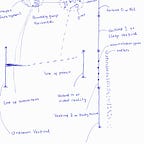Neuroscience: New Mental Health | Addiction Mechanism of the Brain
The picture above describes how the brain works. But what seems to be an answer may also be a problem. There are many ways the brain is explained to function that is not particularly adaptable to care for mental health, substance abuse and addictions.
An angry face is linked with the eyes, blood vessels dilation, prefrontal cortex, amygdala, teeth grinding and so on.
But, what is the mechanism of how a trigger event got to the brain and followed a sequence for what was experienced?
There are rules the brain follows to make a glass of water left on work papers by another individual cause intense rage.
In that state, if someone was told that looking out the window would result in calm, and it does, what are the rules the brain followed?
Where in the brain does the situation and an offset meet, to result in behavioral shifts?
If someone is lonely and social groups work, what were the rules the brain followed?
Both experiences are known.
Knowing is memory.
Memory can be described as locations across the brain for storing information.
There is a function of memory — responsible for mental health, serious mental illness, addictions, substance abuse, biopsychosocial therapy and so on — starting from external stimuli.
First, all sensory inputs converge in the thalamus except smell, converging at the olfactory bulb.
It is where they are processed, before relay to other parts of the cortex for interpretation.
It can be hypothesized that sensory processing or integration is into a uniform unit or quantity which is thought or a form of thought.
The glass of water in the external is a thought form [of glass of water] to the brain.
It is what gets relayed. So thought becomes the version, representation or equivalent of the sense that came in, and that is what goes on for interpretation.
Interpretation in the cerebral cortex can be theorized to be knowing, feeling and reaction.
Knowing is memory.
Memory stores thought or a form of thought.
Stores are in the smallest possible unit of unique information on anything known, while similarities are grouped.
This means that things of different types are stored in the most unique form, but similarities between them collect together.
During activities and interactions, stores are constantly transporting to groups, for what to understand, remember, feel-like and so on.
In the memory, all senses [internal and external] have representatives, versions or equivalents as stores and groups.
It is how these equivalents interchange, via their stores and groups, that make thought and memory shape mental health and addiction.
Situation could be anger, offset is therapy, both meet in the memory, when the store and group of the therapy get prioritized relays, anger vanishes.
Though beyond the memory, there is the feelings destination, where feeling effects are, then reaction — parallel or perpendicular, the memory prepares what to feel and react.
Everything is a group in the memory, including how to be cautious, understand etiquette, adapt to cultural norms and so on. Problems with memory areas, or with store transport to groups can be linked with cases of neurodevelopmental disorders, schizophrenia, bipolar disorder and so on.
Since cells and molecules in the brain build thought and memory, when medications inhibit or induce a synaptic target, the resulting side effects or withdrawal effects are due effect on the whole, even though the specific target was helpful against a condition.
The memory is the dominant function of the brain, including for psychosomatic affect, where during panic or anger, the heart races fast and breathing goes up, because their store in the memory, went to the group in the principal spot, or got less attention. It is also the memory that oversees reaction like teeth grinding. Pain is a feeling effect, though pain is also a group in the memory.
Depression can be described to be a group in the memory staying in the principal spot, attracting stores, stymying general transport, resulting in the experience of feeling heavy.
In moving forward against mental conditions and addictions, thought and memory as basis of how the brain works is a key to better care, possible for design with digital.
